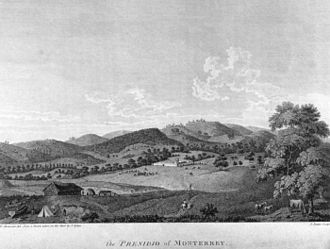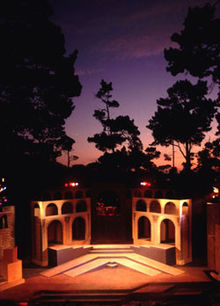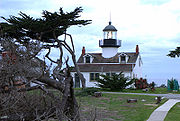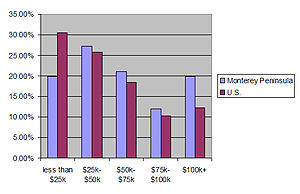- Monterey Peninsula
-
The Monterey Peninsula is located on the central California coast and comprises the cities of Monterey, Carmel, and Pacific Grove, and unincorporated areas of Monterey County including the resort and community of Pebble Beach.
Contents
History
Monterey
 The Presidio of Monterrey". Volume II, plate V from: "A Voyage of Discovery to the North Pacific Ocean and Round the World" by Captain George Vancouver
The Presidio of Monterrey". Volume II, plate V from: "A Voyage of Discovery to the North Pacific Ocean and Round the World" by Captain George Vancouver
The city of Monterey was founded in 1777 and marked the beginning of settlement in upper Las Californias in New Spain. The city became the capital of Spanish and later Mexican Alta California. Up until the mid 19th century the city served as California's cultural and political center. Monterey is home to some of California's oldest buildings, adobes, as well as California's first theatre.
Monterey was founded in 1770 by missionary Junípero Serra and explorer Gaspar de Portolà. Portolà was also the founder of San Diego (1769), and the Spanish governor of Las Californias (1767–1770) which included the Baja California Peninsula and the alta or upper mainland. Portolà erected the Presidio of Monterey to defend the port against an expected Russian trading and settlement invasion.[1] Monterey served as the capital of upper Las Californias and Alta California from 1777 to 1848, under the flags of Spain, independent Mexico, and the United States as a territory. The city was originally the only port of entry for taxable goods in California. All shipments into California by sea were required to go through the Custom House, the oldest governmental building in the state, and California's Historic Landmark Number One.[2] Built in 3 phases, construction on the Custom House began in 1814 under the Spanish, the center section under Mexican rule in 1827, with the lower end completed by the United States in 1846.[3] Monterey was also the site of the July 7, 1846, Battle of Monterey during the Mexican-American War. It was on this date that John D. Sloat, Commodore in the United States Navy, raised the U.S. flag over the Monterey Custom House and claimed California for the United States.
In addition, many California "firsts" occurred in Monterey. These include California's first theater, brick house, publicly funded school, public building, public library, and printing press, which printed The Californian, the first newspaper. Colton Hall,[4] built in 1849 by Walter Colton, was originally a public school and government meeting place. It also hosted California's first constitutional convention. Today it houses a museum, while adjacent buildings serve as the seat of local government. The Monterey post office opened in 1849. Monterey incorporated in 1889.
The city has a noteworthy history as a center for California painters in the late 19th and early 20th centuries. Such painters as Arthur Frank Mathews, Armin Hansen, Xavier Martinez, Rowena Meeks Abdy and Percy Gray lived or visited to pursue painting in the style of either En plein air or Tonalism. In addition to painters many noted authors through the years have also lived in and around the Monterey area such as John Steinbeck, Robinson Jeffers, Robert A. Heinlein, Henry Miller, Ed Ricketts, and Robert Louis Stevenson. More recently, Monterey has been recognized for its significant involvement in post-secondary learning of languages other than English and its major role in delivering translation and interpretation services around the world. In November 1995, California Governor Pete Wilson proclaimed Monterey as "The Language Capital of the World".
Pacific Grove
Pacific Grove was founded in 1875 by a group of Methodists who modeled the town after Ocean Grove, New Jersey.[5] In time, the butterflies, fragrant pines and fresh sea air brought others to the Pacific Grove Retreat to rest and meditate. The initial meeting of the Pacific Coast branch of the Chautauqua Literary and Scientific Circle was held in Pacific Grove in June 1879. Modelled after the Methodist Sunday school teachers’ training camp established in 1874 at Lake Chautauqua, N.Y., this location became part of a nationwide educational network. In November 1879, after the summer campers returned home, Robert Louis Stevenson wandered into the deserted campgrounds: "I have never been in any place so dreamlike. Indeed, it was not so much like a deserted town as like a scene upon the stage by daylight, and with no one on the boards." Today, Stevenson School in nearby Pebble Beach is named after the author. The Pacific Grove post office opened in 1886, closed later that year, and was re-opened in 1887.[5] Pacific Grove incorporated in 1889.[5]
Pacific Grove, like Carmel-by-the-Sea and Monterey, became an artists' haven in the 1890s and subsequent period. Artists of the En plein air school in both Europe and the United States were seeking an outdoor venue which had natural beauty, so that Pacific Grove was a magnet for this movement. William Adam was an English painter who first moved to Monterey and then decided on Pacific Grove for his home in 1906. At about the same time Eugen Neuhaus, a German painter, arrived in Pacific Grove with his new bride. Charles B. Judson was an artist of aristocratic lineage who painted in Pacific Grove over a long period of time beginning in 1907; Judson's murals decorate the halls of the California Academy of Sciences. For a number of years, John Steinbeck lived in a cottage in Pacific Grove owned by his father, Ernest, who was Monterey County Treasurer. The cottage still stands on a quiet side street, without any plaque or special sign, virtually overlooked by most Steinbeck fans. In Steinbeck's book Sweet Thursday, a chapter is dedicated to describing a (probably fictional) rivalry that arose among the town's residents over the game of roque.
The Point Piños Light in Pacific Grove is the oldest continually operating lighthouse on the West Coast of the United States. It was built in 1855, and has served as an aid to navigation ever since.
Carmel-by-the-Sea
In 1902 James Frank Devendorf and Frank Powers, on behalf of the Carmel Development Company, filed a new subdivision map of the core village that became Carmel-by-the-Sea. The Carmel post office opened the same year.[5] In 1910, the Carnegie Institution established the Coastal Laboratory, and a number of scientists moved to the area. Carmel incorporated in 1916.[5]
 Sunset over the 1994 Carmel Shakespeare Festival production of Julius Caesar at Carmel's historic Forest Theater
Sunset over the 1994 Carmel Shakespeare Festival production of Julius Caesar at Carmel's historic Forest Theater
In 1905 the Carmel Arts and Crafts Club was formed to support and produce artistic works. After the 1906 San Francisco earthquake the village was inundated with musicians, writers, painters other artists turning to the established artist colony after the bay city was destroyed. The new residents were offered home lots - ten dollars down, little or no interest, and whatever they could pay on a monthly basis.[6] In 1907 the town's first cultural center and theatre, the Carmel Arts and Crafts Clubhouse, was built. Poets Austin and Sterling performed their "private theatricals" there.
In 1911, the town's rich Shakespearean tradition began with a production of Twelfth Night, directed by Garnet Holme of UC Berkeley and featuring future mayors Perry Newberry and Herbert Heron, with settings designed by artist DeNeale Morgan.[7] By 1914, the club had achieved national recognition, with an article The Mercury Herald commenting "...a fever of activity seems to have seized the community and each newcomer is immediately inoculated and begins with great enthusiasm to do something... with plays, studios and studies...".[8] In 1913, The Arts and Crafts Club began organizing lessons for aspiring painters, actors & craftsmen.[9] Some of the most prominent painters in the United States, such as William Merritt Chase, Xavier Martinez, Mary DeNeale Morgan and C. Chapel Judson offered six weeks of instruction for $15. Jack London describes the artists' colony in his novel, The Valley of the Moon; among the noted artists lived or frequented the village were; Mary Austin, Armin Hansen, George Sterling, Ambrose Bierce, Upton Sinclair, Robinson Jeffers, Sinclair Lewis, Sydney Yard, Ferdinand Burgdorff, William Frederic Ritschel, William Keith, Percy Gray, Arnold Genthe, and Nora May French.
In 1924, the Arts and Crafts Hall was built on a site adjacent to the original clubhouse. This new facility was renamed numerous times including the Abalone Theatre, the Filmarte, the Carmel Playhouse and, finally, the Studio Theatre of the Golden Bough. The original clubhouse, along with the adjoining theatre, burned down in 1949. The facilities were rebuilt as a two-theatre complex, opening in 1952 as the Golden Bough Playhouse.[8]
Fishing Industry
In the late 19th century the fishing industry became the area's most profitable and important economic sector. Started by mostly Italian immigrants in Monterey and Chinese immigrants in Pacific Grove, the fishing industry flourished. By the 1930s canneries lined the northern shore of the Peninsula. These canneries were the setting for the novels Cannery Row and Sweet Thursday by famed local author John Steinbeck. By the early 1940s, however, the fishing industry was dealt a devastating blow when the heavily overfished waters did not yield the amounts of fish needed to keep the canneries in the green. The end of big business fishing on the Monterey County was the beginning of several conservation efforts which eventually led to the creation of the Monterey Bay National Marine Sanctuary.
Tourism
While the fishing industry was very important to the area, so was tourism. The Hotel Del Monte, built in 1880, was the first true resort complex in the United States and was the forerunner to today's Pebble Beach Company. It became popular with the wealthy and influential of the day, and hosted guests from Theodore Roosevelt to Ernest Hemingway, as well as many early Hollywood stars. A train station was built in Monterey expressly for the purpose of bringing visitors to the resort, and the Del Monte name is still frequently seen around town. The Hotel Del Monte was requisitioned by the Navy at the beginning of World War II, and is now the central building of the Naval Postgraduate School.
The hotel's park reservation, originally used for hunting and other outdoor activities, became Pebble Beach, an unincorporated community and well-known golf resort area. The famous 17-Mile Drive was originally designed as a local excursion for visitors to the Del Monte, in which they could take in the historic sights of Monterey and Pacific Grove and the scenery of what would become Pebble Beach.[10]
Today, tourism is serves as the Peninsula's main industry. The old Cannery Row is a tourist center lined with boutiques, restaurants, and hotels.
Unique Flora and Natural History
The Monterey Peninsula has a high degree of species endemism. Additionally it presents a unique combination of species due to overlap of species with more northerly versus more southerly ranges. The Monterey Peninsula is influenced by a marine climate that is pronounced due to the upwelling of cool water from the Monterey submarine canyon. Rainfall is 40 to 50 centimeters per year, but summer fog drip is a primary source of moisture for plants that would otherwise not be able to persist with such low precipitation. Some taxa, such as the coastal closed-cone pines including Monterey Pine and Monterey Cypress are relict stands, i.e. species that once extended more widely in the mesic climate of the late Pleistocene epoch, but then retreated to small pockets of cooler and wetter conditions along the coast ranges during the hotter, drier early and middle Holocene epoch between 6000 and 2000 BC.[11]
A variety of natural habitats are found on the Monterey Peninsula: littoral zone and sand dunes; closed cone pine forest; and Monterey Cypress. During the early 1900s, Willis Linn Jepson characterized the forests on the Monterey Peninsula as the "most important silva ever", and encouraged Samuel F. B. Morse of the Del Monte Properties Company to explore the possibilities of preserving the unique forest communities.[12] The dune area is also important, as it hosts endangered species such as the vascular plants Seaside birds beak and Eastwoods Ericameria. The closed cone pine forest habitat is dominated by Monterey pine, Knobcone Pine and Bishop Pine, and contains the rare Monterey manzanita and endangered Hickman's potentilla and Yadon's piperia; rare plants inhabiting chaparral habitat in Monterey are: Hickman's onion and Sandmat manzanita. Other rare plants on the peninsula are: Hutchinson's larkspur, Tidestrom lupine; Gardner's yampah and Monterey Knotweed
Marine Protected Areas
Soquel Canyon State Marine Conservation Area, Portuguese Ledge State Marine Conservation Area, Pacific Grove Marine Gardens State Marine Conservation Area, Lovers Point State Marine Reserve, Edward F. Ricketts State Marine Conservation Area and Asilomar State Marine Reserve are marine protected areas in Monterey Bay. Like underwater parks, these marine protected areas help conserve ocean wildlife and marine ecosystems.
Demographics
At the 2000 Census, the Peninsula (Monterey, Pacific Grove, Carmel and Pebble Beach) had 53,808 residents, 84.8% of whom were White, 8.5% Hispanic or Latino, 6.0% Asian or Pacific Islander and 1.8% were African American. The Peninsula was considerably more affluent than the national average, with the percentage of household with six figure incomes being 60% higher and the percentage of household with incomes of less than $25,000 being 54% lower than the national average. In terms of income distribution 19.8% of households had incomes of less than $25,000, while 27.2% had incomes between $25,000 and $50,000, 21.1% incomes between $50,000 and $75,000, 11.9% incomes between $75,000 and $100,000 and 19.8% had incomes exceeding $100,000 compred to compared to 30.5%, 25.8%, 18.4%, 10.3% and 12.3% at the national level, respectively.
See also
References
- ^ NHL Summary
- ^ State Parks: Custom House
- ^ http://www.planetware.com/monterey/custom-house-us-ca-mnch.htm
- ^ Colton Hall web page. Retrieved on2008-03-14.
- ^ a b c d e Durham, David L. (1998). California's Geographic Names: A Gazetteer of Historic and Modern Names of the State. Quill Driver Books. p. 881. ISBN 9781884995149.
- ^ Barbara J. Klein, The Carmel Monterey Peninsula Art Colony: A History, accessed at http://www.tfaoi.com/aa/5aa/5aa300.htm
- ^ Harold and Ann Gilliam, Creating Carmel, The Enduring Vision, Peregrine Smith Books, 1992
- ^ a b http://www.californianprepress.com/thecalifornian/specialsections/uploads/ads/NonProfits05/NonProfit09.pdf
- ^ Monica Hudson,Carmel-By-The-Sea, Arcadia Publishing, 2006
- ^ The Hotel Del Monte, California's Most Historic Resort' Publisher: Naval Postgraduate School
- ^ C.I. Millar, Reconsidering the Conservation of Monterey Pine. Fremontia 26(3):12–16 (1998)
- ^ U.S. Federal Register: August 2, 1995 (Volume 60, Number 148, Pages 39326-39337
External links
- Monterey County Official Web-Site
- City of Monterey Official Web-Site
- City of Pacific Grove Official Web-Site
- City of Carmel Official Web-Site
- Pebble Beach Official Web-Site
- Monterey Peninsula official visitor information from the Monterey County Convention and Visitors Bureau
- Monterey Peninsula Factoids blog
Categories:- Peninsulas of California
- Landforms of Monterey County, California
- Regions of California
Wikimedia Foundation. 2010.



